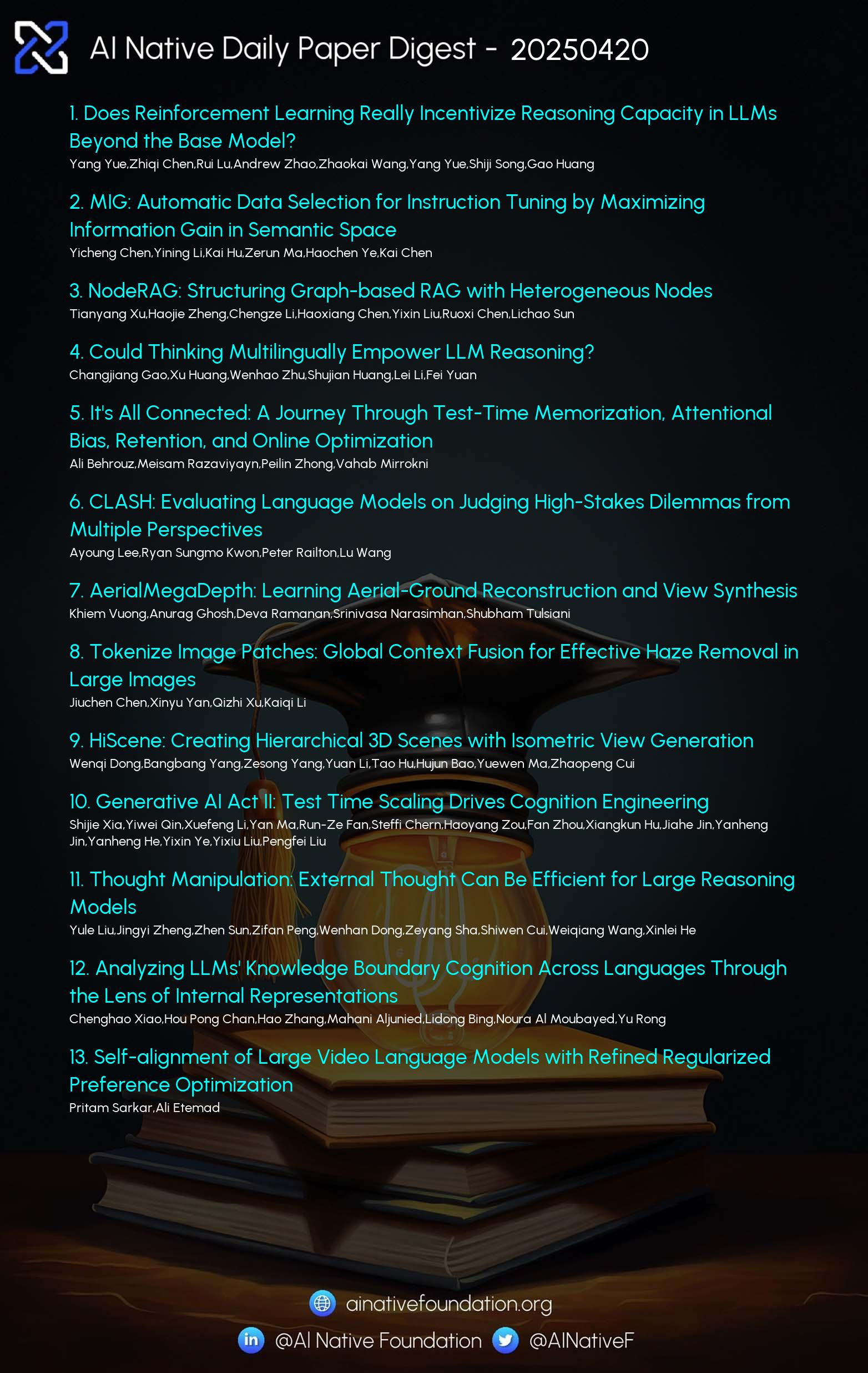AI Native Daily Paper Digest – 20250421

1. Does Reinforcement Learning Really Incentivize Reasoning Capacity in LLMs Beyond the Base Model?
🔑 Keywords: Reinforcement Learning, Verifiable Rewards, reasoning capabilities, base models, distillation
💡 Category: Reinforcement Learning
🌟 Research Objective:
– Critically examine the assumption that Reinforcement Learning with Verifiable Rewards (RLVR) fundamentally improves the reasoning capabilities of Large Language Models (LLMs).
🛠️ Research Methods:
– Utilize the pass@k metric with large k values to analyze the reasoning capability of models across various model families and benchmarks.
💬 Research Conclusions:
– RL-trained models outperform base models at smaller k values, but base models achieve similar or higher pass@k scores at larger k values.
– RLVR tends to narrow the model’s reasoning capability by biasing output distribution towards known paths.
– Distillation can introduce genuinely new knowledge, contrasting RLVR’s limitations.
– The study calls for a reevaluation of RL training’s role in advancing reasoning abilities in LLMs.
👉 Paper link: https://huggingface.co/papers/2504.13837
2. MIG: Automatic Data Selection for Instruction Tuning by Maximizing Information Gain in Semantic Space
🔑 Keywords: Data Quality, Diversity, Semantic Space, Information Gain, Instruction-Tuning
💡 Category: Natural Language Processing
🌟 Research Objective:
– To propose a unified method for quantifying the information content of instruction-tuning datasets, enhancing data quality and diversity.
🛠️ Research Methods:
– The study models the semantic space using a label graph and introduces an efficient sampling method to maximize Information Gain (MIG) for selecting high-quality data subsets.
💬 Research Conclusions:
– The proposed MIG method consistently outperforms state-of-the-art approaches, achieving significant performance improvements in model fine-tuning with a reduced dataset.
👉 Paper link: https://huggingface.co/papers/2504.13835
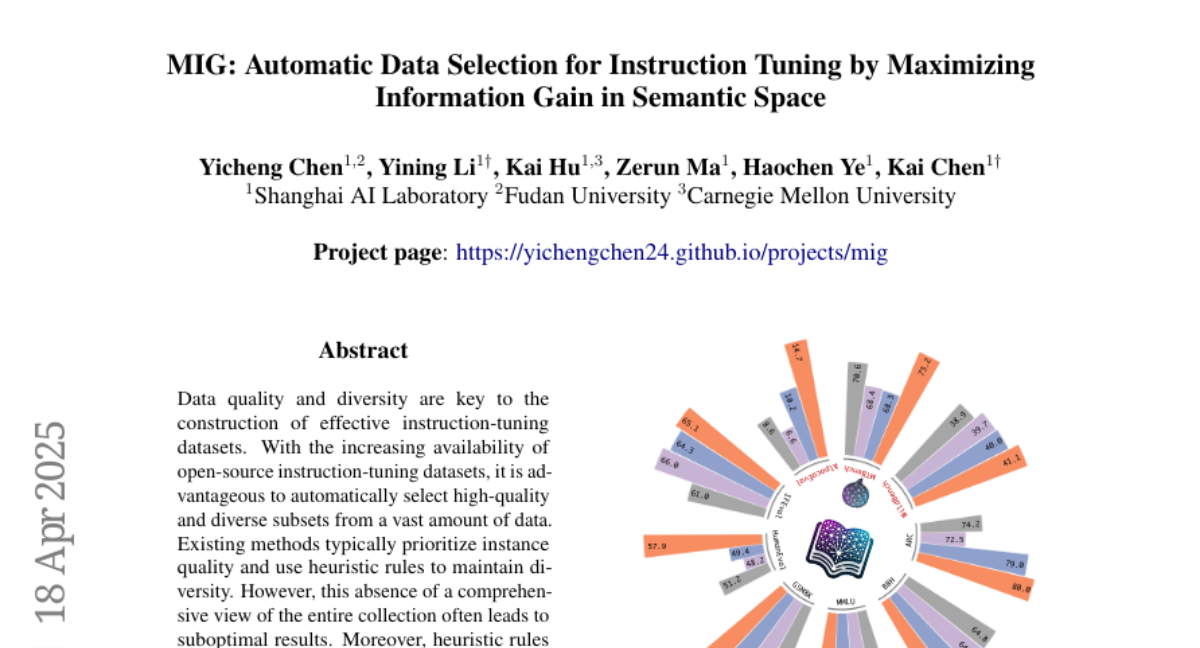
3. NodeRAG: Structuring Graph-based RAG with Heterogeneous Nodes
🔑 Keywords: Retrieval-augmented generation, Graph-based RAG, NodeRAG, Heterogeneous graph structures, Question-answering performance
💡 Category: Knowledge Representation and Reasoning
🌟 Research Objective:
– The study aims to enhance retrieval-augmented generation (RAG) by proposing a graph-centric framework called NodeRAG, focusing on the integration of heterogeneous graph structures to improve factually consistent responses in specific domains.
🛠️ Research Methods:
– The framework introduces heterogeneous graph structures to ensure seamless and holistic integration of graph-based methodologies into the RAG workflow, aligning closely with the capabilities of large language models for a cohesive end-to-end process.
💬 Research Conclusions:
– Through extensive experimentation, NodeRAG demonstrates superior performance over methods like GraphRAG and LightRAG in terms of indexing time, query time, storage efficiency, and question-answering on multi-hop benchmarks. The full framework and results can be explored on their GitHub repository.
👉 Paper link: https://huggingface.co/papers/2504.11544
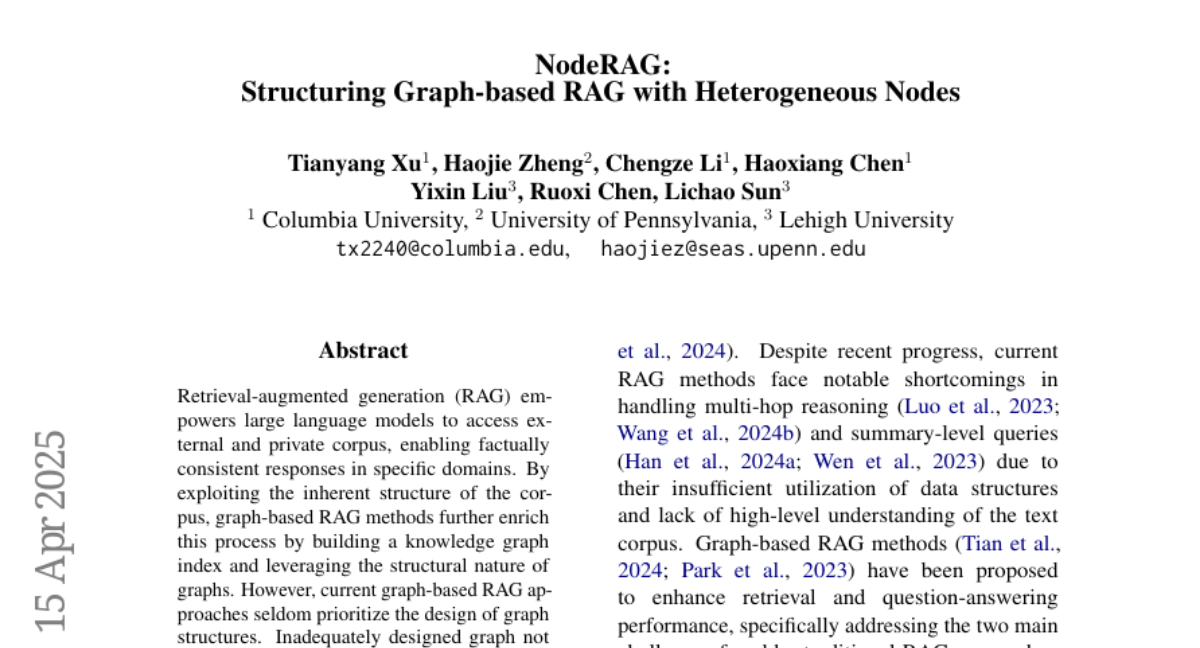
4. Could Thinking Multilingually Empower LLM Reasoning?
🔑 Keywords: Large Language Models, English Bias, Multilingual Reasoning, AI Ethics and Fairness
💡 Category: Natural Language Processing
🌟 Research Objective:
– To explore the potential of multilingual reasoning in overcoming the English bias of large language models and achieving better performance on reasoning tasks than English-only approaches.
🛠️ Research Methods:
– Investigation of the performance ceiling of multilingual reasoning tasks, analyzing variations in translation quality and language selection, and evaluating current answer selection methods.
💬 Research Conclusions:
– Multilingual reasoning tasks offer significantly higher and more robust performance upper bounds compared to English-only tasks. However, common answer selection methods are insufficient in reaching this potential, indicating an area for further research and improvement.
👉 Paper link: https://huggingface.co/papers/2504.11833

5. It’s All Connected: A Journey Through Test-Time Memorization, Attentional Bias, Retention, and Online Optimization
🔑 Keywords: attentional bias, associative memory modules, retention regularization, language modeling, Transformers
💡 Category: Natural Language Processing
🌟 Research Objective:
– To design efficient architectural backbones for neural architectures inspired by human attentional bias.
🛠️ Research Methods:
– Reconceptualizing neural architectures like Transformers and Titans as associative memory modules.
– Introduction of alternative attentional bias configurations and a framework called Miras with choices for architectural design.
💬 Research Conclusions:
– Proposed novel sequence models Moneta, Yaad, and Memora surpass existing linear RNNs in tasks such as language modeling and outperform traditional models like Transformers in specific scenarios.
👉 Paper link: https://huggingface.co/papers/2504.13173
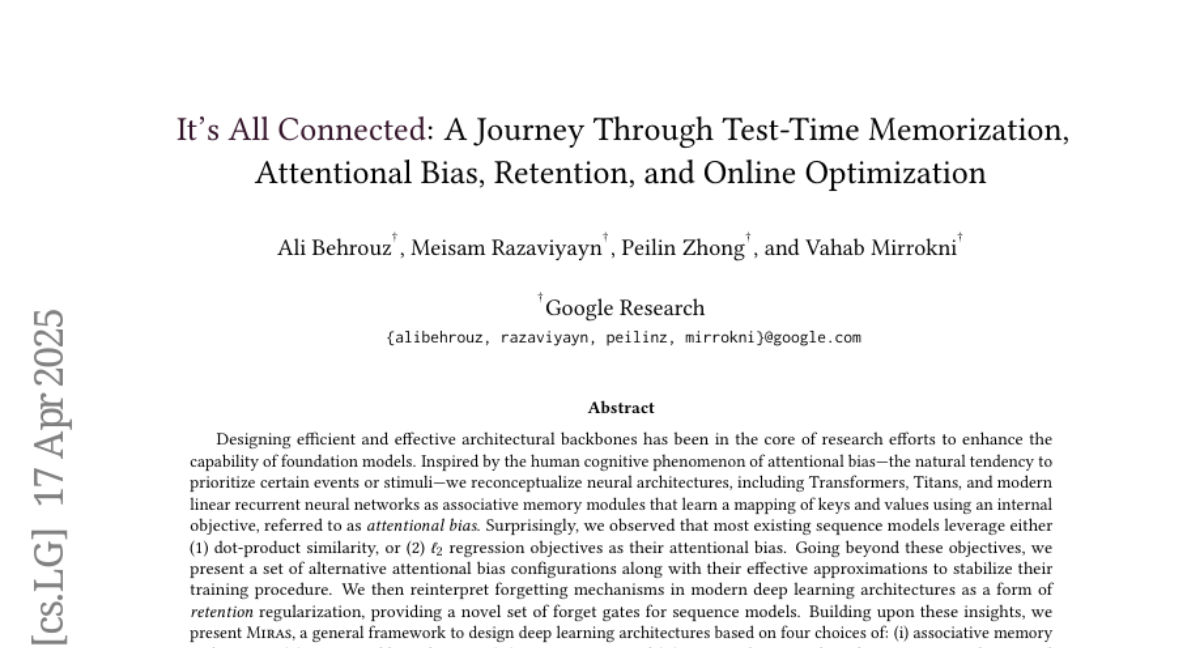
6. CLASH: Evaluating Language Models on Judging High-Stakes Dilemmas from Multiple Perspectives
🔑 Keywords: Large Language Models, CLASH, Decision Ambivalence, Psychological Discomfort, Value Shifts
💡 Category: Natural Language Processing
🌟 Research Objective:
– To develop a dataset, CLASH, for evaluating Large Language Models (LLMs) in high-stakes dilemmas involving conflicting values.
🛠️ Research Methods:
– Introduction of CLASH dataset with 345 dilemmas and 3,795 perspectives, benchmarked 10 frontier models to study decision-making processes.
💬 Research Conclusions:
– LLMs show less than 50% accuracy in ambivalent decision scenarios; perform better in clear-cut situations.
– Models predict psychological discomfort accurately but struggle with value shifts.
– A significant connection between value preferences and steerability is observed, with third-party perspectives enhancing steerability.
👉 Paper link: https://huggingface.co/papers/2504.10823

7. AerialMegaDepth: Learning Aerial-Ground Reconstruction and View Synthesis
🔑 Keywords: geometric reconstruction, extreme viewpoint variation, co-registered, pseudo-synthetic renderings, domain gap
💡 Category: Computer Vision
🌟 Research Objective:
– The study aims to improve geometric reconstruction of images from mixed ground and aerial views by addressing the extreme viewpoint variation issue.
🛠️ Research Methods:
– Developed a scalable framework that combines pseudo-synthetic renderings from 3D city-wide meshes with real, crowd-sourced images to create a hybrid dataset for fine-tuning algorithms.
💬 Research Conclusions:
– Fine-tuning state-of-the-art algorithms with the new dataset significantly improves accuracy in handling large viewpoint changes, raising localization accuracy from under 5% to nearly 56%.
– The dataset also enhances performance on tasks like novel-view synthesis in challenging scenarios, showcasing the practical value of the approach in real-world applications.
👉 Paper link: https://huggingface.co/papers/2504.13157
8. Tokenize Image Patches: Global Context Fusion for Effective Haze Removal in Large Images
🔑 Keywords: DehazeXL, haze removal, global context, local feature extraction, ultra-high-resolution dataset
💡 Category: Computer Vision
🌟 Research Objective:
– The study aims to improve haze removal for large, high-resolution images while balancing global context and local feature extraction.
🛠️ Research Methods:
– DehazeXL is proposed as a haze removal method enabling end-to-end modeling of large images on mainstream GPUs.
– A visual attribution method is designed to evaluate global context utilization, and an ultra-high-resolution haze removal dataset (8KDehaze) is developed for model training and testing.
💬 Research Conclusions:
– DehazeXL demonstrates state-of-the-art performance, handling images up to 10240×10240 pixels with only 21 GB of GPU memory.
– The model outperforms all evaluated methods, proving the effectiveness of the proposed approach and dataset.
👉 Paper link: https://huggingface.co/papers/2504.09621
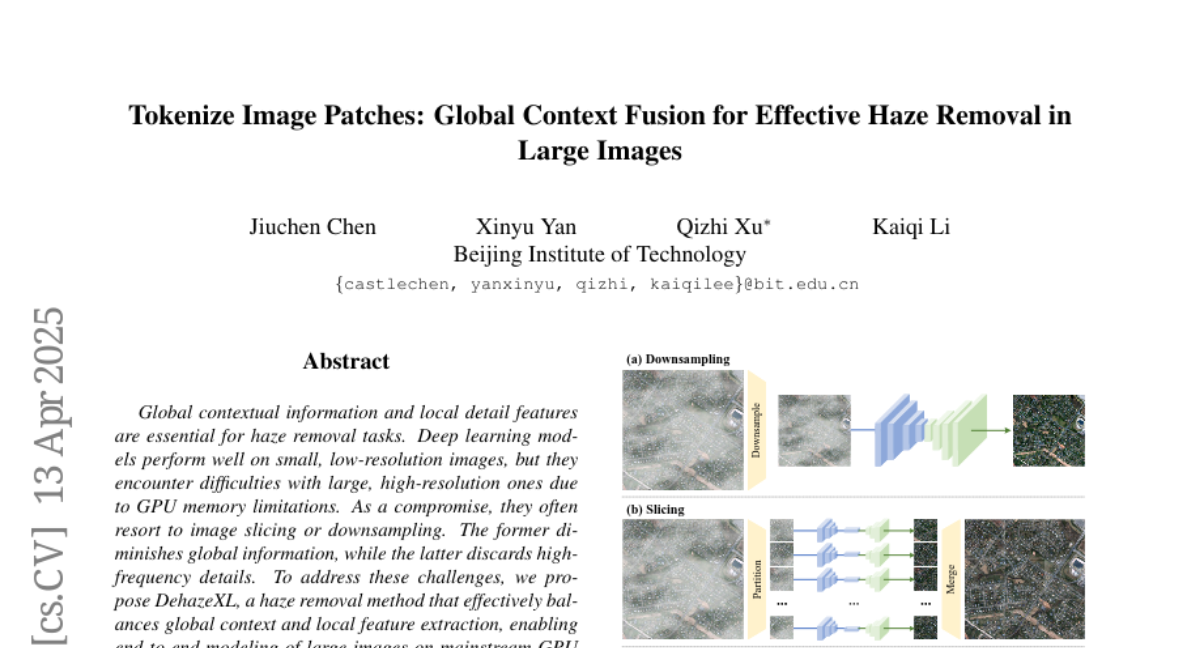
9. HiScene: Creating Hierarchical 3D Scenes with Isometric View Generation
🔑 Keywords: Scene-level 3D generation, Hierarchical framework, 2D image generation, 3D object generation, Interactive applications
💡 Category: Generative Models
🌟 Research Objective:
– To develop HiScene, a novel hierarchical framework that bridges the gap between 2D and 3D generation, aiming to create high-fidelity and aesthetically pleasing 3D scenes with compositional identities.
🛠️ Research Methods:
– Using a hierarchical approach to treat scenes as objects and utilizing a video-diffusion-based amodal completion technique for handling occlusions and maintaining spatial coherence through shape prior injection.
💬 Research Conclusions:
– The proposed method of HiScene produces more natural and physically plausible object arrangements suitable for interactive applications, aligning well with user inputs and maintaining compositional structure.
👉 Paper link: https://huggingface.co/papers/2504.13072
10. Thought Manipulation: External Thought Can Be Efficient for Large Reasoning Models
🔑 Keywords: Large Reasoning Models, ThoughtMani, CoT generator, safety alignment
💡 Category: Knowledge Representation and Reasoning
🌟 Research Objective:
– Address the “overthinking” issue in Large Reasoning Models (LRMs) by developing a method to reduce redundant reasoning steps and computational cost.
🛠️ Research Methods:
– Introduce ThoughtMani, a pipeline leveraging CoTs from smaller models to streamline LRMs’ reasoning process and empirically validate its efficiency on datasets like LiveBench/Code.
💬 Research Conclusions:
– ThoughtMani achieves a reduction in output token count by 30% while maintaining performance, and enhances safety alignment by an average of 10%, making it an effective tool for constructing efficient LRMs.
👉 Paper link: https://huggingface.co/papers/2504.13626
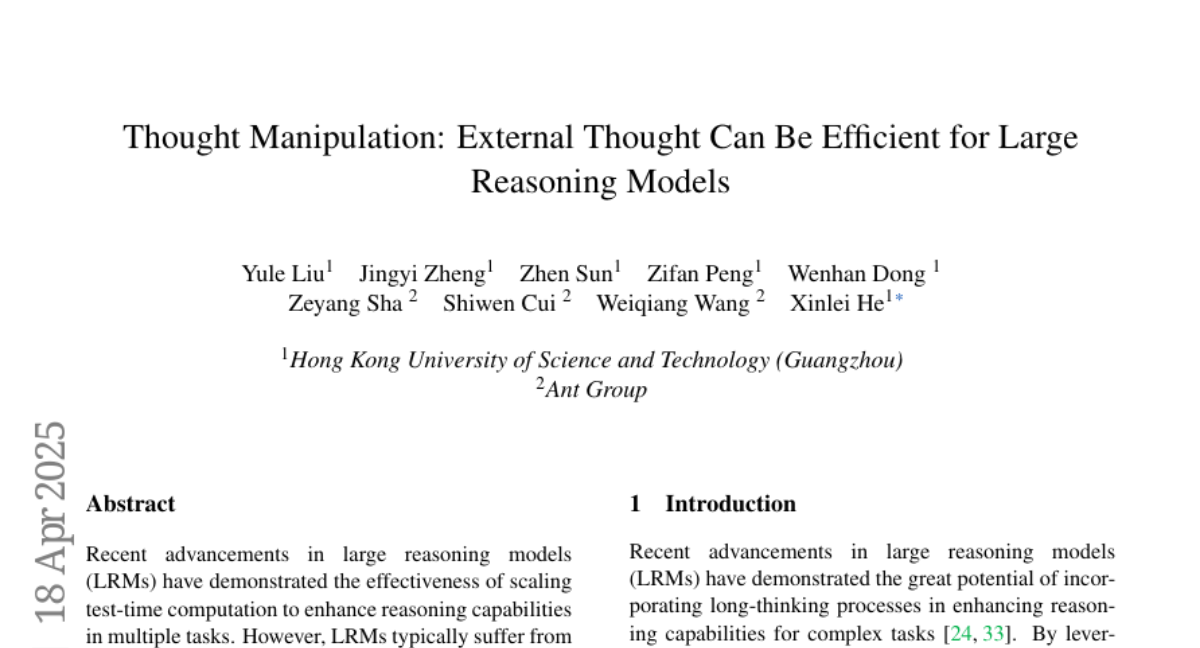
11. Generative AI Act II: Test Time Scaling Drives Cognition Engineering
🔑 Keywords: Large Language Models, generative AI, cognition engineering, test-time scaling, prompt engineering
💡 Category: Foundations of AI
🌟 Research Objective:
– To clarify the conceptual foundations of cognition engineering and highlight its critical development phase in AI’s “Act II”.
🛠️ Research Methods:
– Comprehensive tutorials and optimized implementations are provided to democratize access to cognition engineering and engage AI practitioners.
💬 Research Conclusions:
– The emergence of “Act II” allows models to transform from knowledge-retrieval systems to thought-construction engines, enhancing AI through language-based thoughts and mind-level connections.
👉 Paper link: https://huggingface.co/papers/2504.13828
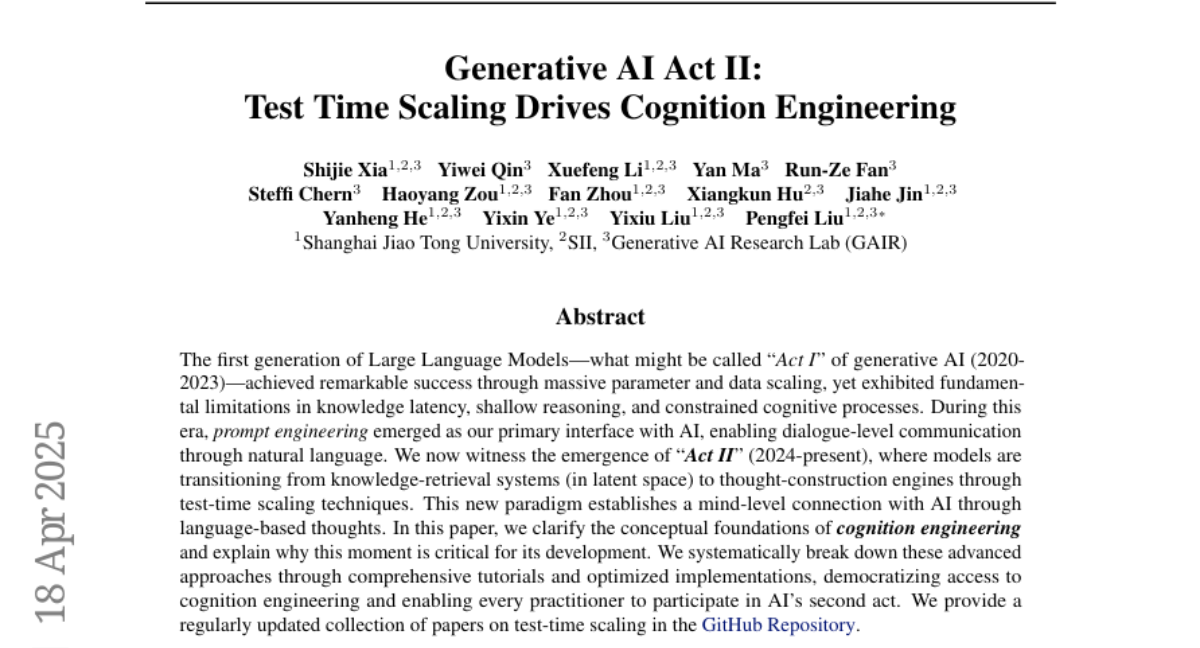
12. Self-alignment of Large Video Language Models with Refined Regularized Preference Optimization
🔑 Keywords: LVLMs, self-alignment, spatio-temporal understanding, RRPO
💡 Category: Multi-Modal Learning
🌟 Research Objective:
– The study aims to address limitations in Large Video Language Models (LVLMs), specifically in fine-grained temporal understanding and error-prone video question-answering tasks.
🛠️ Research Methods:
– Introduction of a self-alignment framework with a training set of preferred and non-preferred response pairs.
– Implementation of Refined Regularized Preference Optimization (RRPO) using sub-sequence-level refined rewards and token-wise KL regularization.
💬 Research Conclusions:
– RRPO results in more precise alignment and stable training than Direct Preference Optimization.
– The effectiveness of the proposed approach is validated across various video tasks, including video hallucination and temporal reasoning.
👉 Paper link: https://huggingface.co/papers/2504.12083
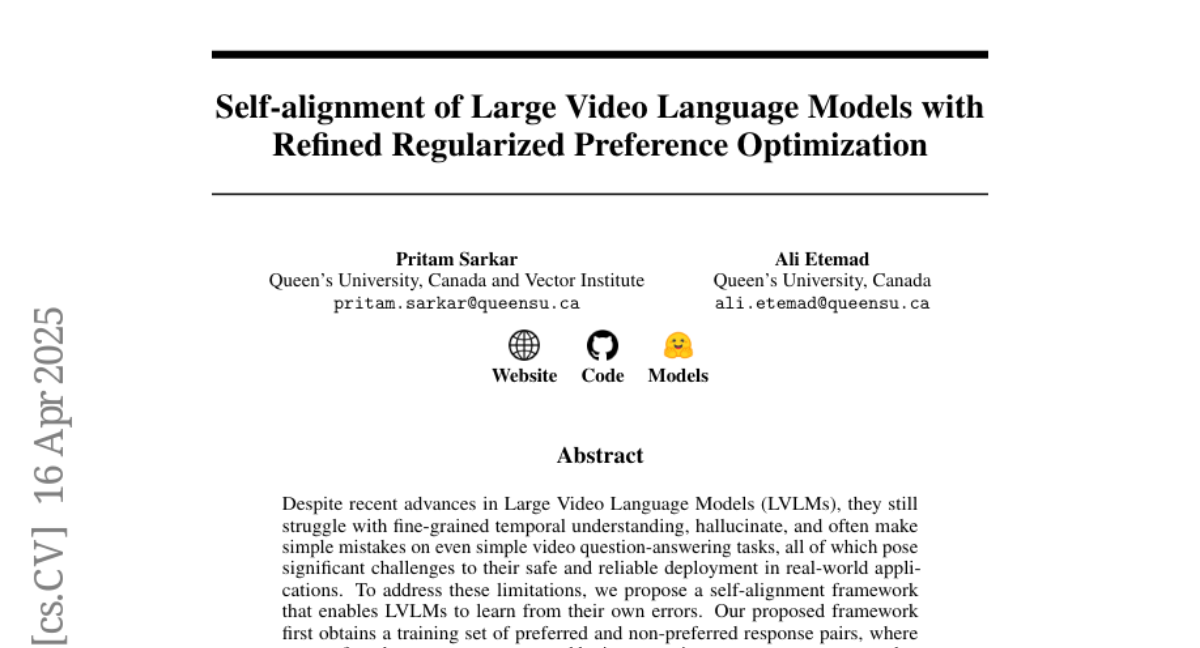
13. Analyzing LLMs’ Knowledge Boundary Cognition Across Languages Through the Lens of Internal Representations
🔑 Keywords: Knowledge Boundaries, LLMs, Training-Free Alignment, Multilingual Evaluation
💡 Category: Natural Language Processing
🌟 Research Objective:
– The study aims to analyze how large language models (LLMs) recognize knowledge boundaries across different languages by examining their internal representations.
🛠️ Research Methods:
– The researchers conducted empirical studies by probing the internal representations of LLMs while processing known and unknown questions across multiple languages. Additionally, they developed a multilingual evaluation suite for cross-lingual knowledge boundary analysis.
💬 Research Conclusions:
– Three primary findings were revealed:
1) LLMs’ perceptions of knowledge boundaries are encoded in the middle to middle-upper layers across languages.
2) A linear structure is observed in language differences, facilitating a training-free alignment method to transfer knowledge boundary perception across languages.
3) Fine-tuning on bilingual question pair translation improves LLMs’ ability to recognize knowledge boundaries across languages.
👉 Paper link: https://huggingface.co/papers/2504.13816
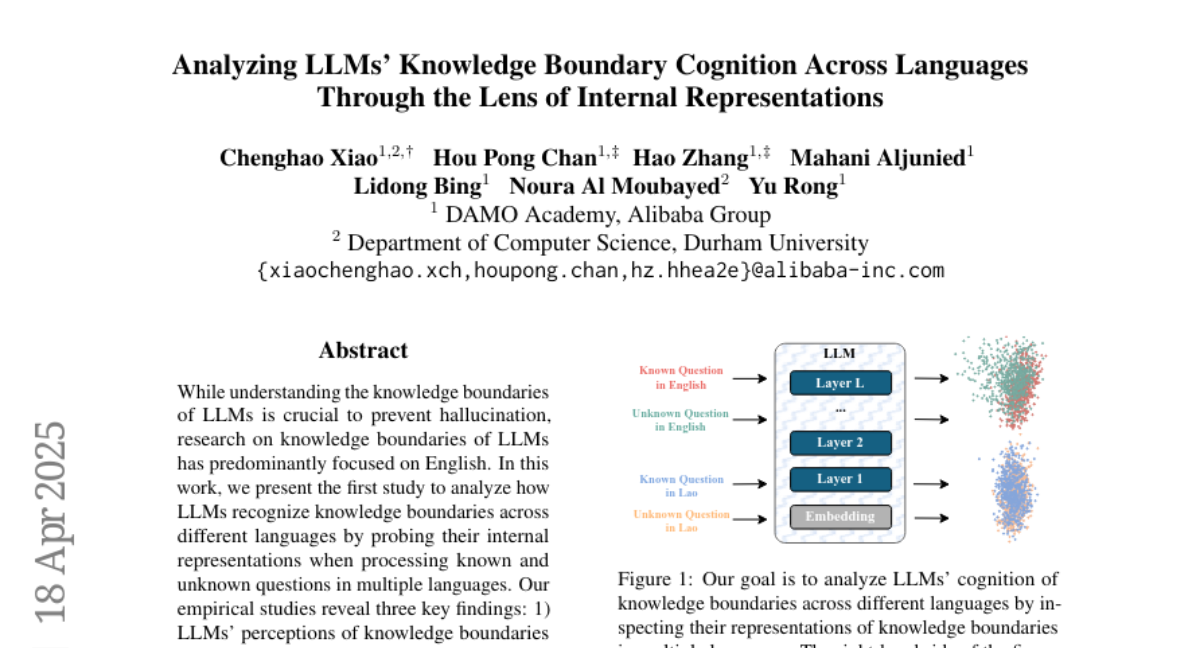
14. Cost-of-Pass: An Economic Framework for Evaluating Language Models
🔑 Keywords: AI systems, economic value, cost-of-pass, lightweight models, reasoning models
💡 Category: Natural Language Processing
🌟 Research Objective:
– The paper aims to evaluate the tradeoff between economic value and inference costs of AI systems using a framework grounded in production theory.
🛠️ Research Methods:
– Introduces the concept of “cost-of-pass” and “frontier cost-of-pass” to assess AI models by combining accuracy and inference cost.
💬 Research Conclusions:
– Innovations in lightweight, large, and reasoning models are crucial for cost-efficiency in respective tasks. Complementary model-level innovations drive significant economic progress in AI system deployment.
👉 Paper link: https://huggingface.co/papers/2504.13359
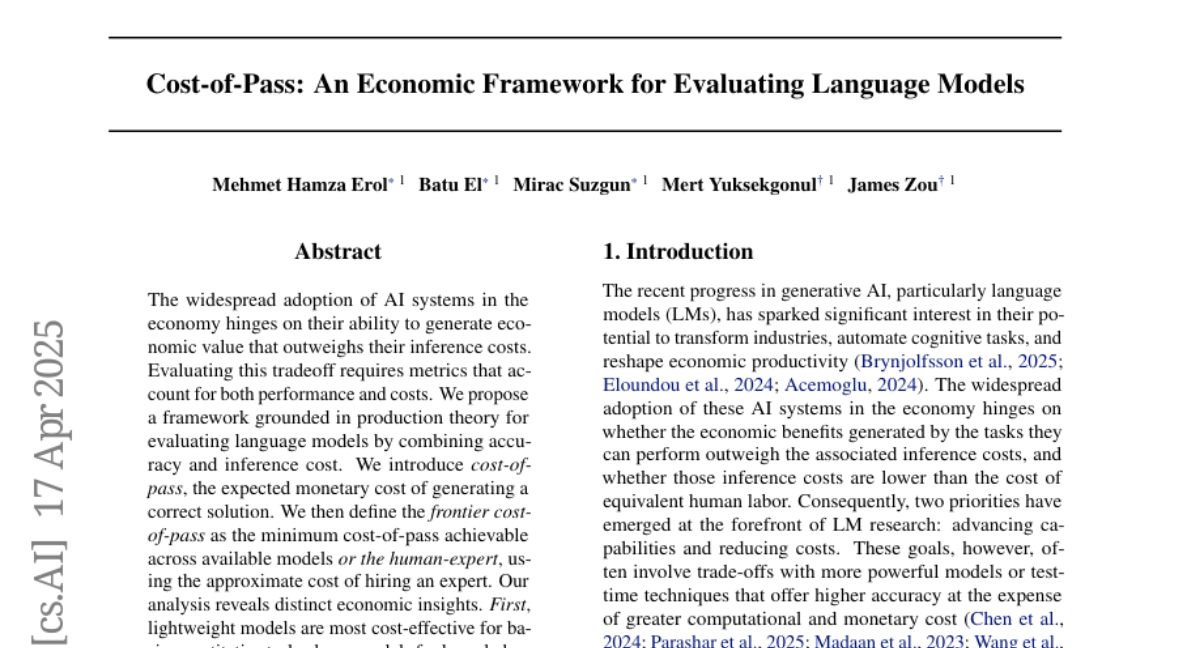
15. Filter2Noise: Interpretable Self-Supervised Single-Image Denoising for Low-Dose CT with Attention-Guided Bilateral Filtering
🔑 Keywords: Low-Dose CT, Self-Supervised, Denoising, Attention-Guided Bilateral Filter
💡 Category: AI in Healthcare
🌟 Research Objective:
– Propose an interpretable self-supervised single-image denoising framework, Filter2Noise (F2N), for low-dose CT scans.
🛠️ Research Methods:
– Introduced an Attention-Guided Bilateral Filter, using a novel downsampling shuffle strategy with a new self-supervised loss function.
💬 Research Conclusions:
– F2N outperforms current methods by improving PSNR by 4.59 dB, enhancing transparency, user control, and parametric efficiency.
👉 Paper link: https://huggingface.co/papers/2504.13519
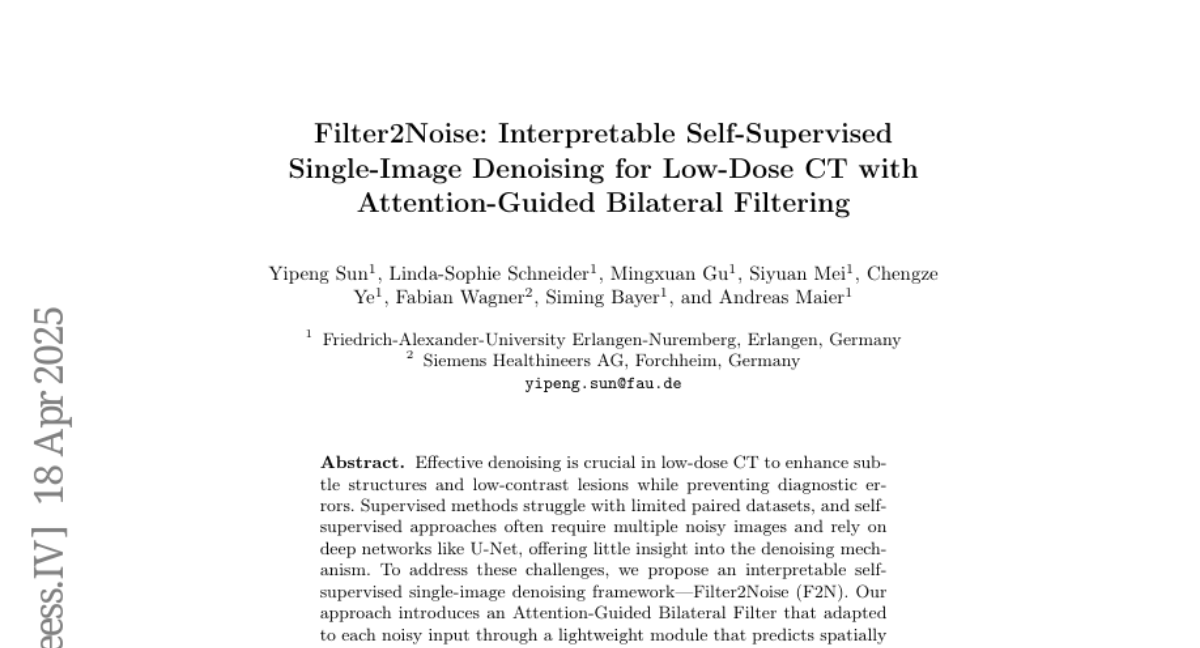
16. Revisiting Uncertainty Quantification Evaluation in Language Models: Spurious Interactions with Response Length Bias Results
🔑 Keywords: Uncertainty Quantification, Language Models, AUROC, Length Biases, LLM-as-a-judge
💡 Category: Natural Language Processing
🌟 Research Objective:
– The study focuses on improving the safety and reliability of Language Models through Uncertainty Quantification.
🛠️ Research Methods:
– Evaluation of seven correctness functions across various datasets, models, and UQ methods, highlighting biases in current performance metrics.
💬 Research Conclusions:
– The analysis identifies LLM-as-a-judge approaches as among the least biased by length, presenting them as a possible solution to mitigate these biases.
👉 Paper link: https://huggingface.co/papers/2504.13677
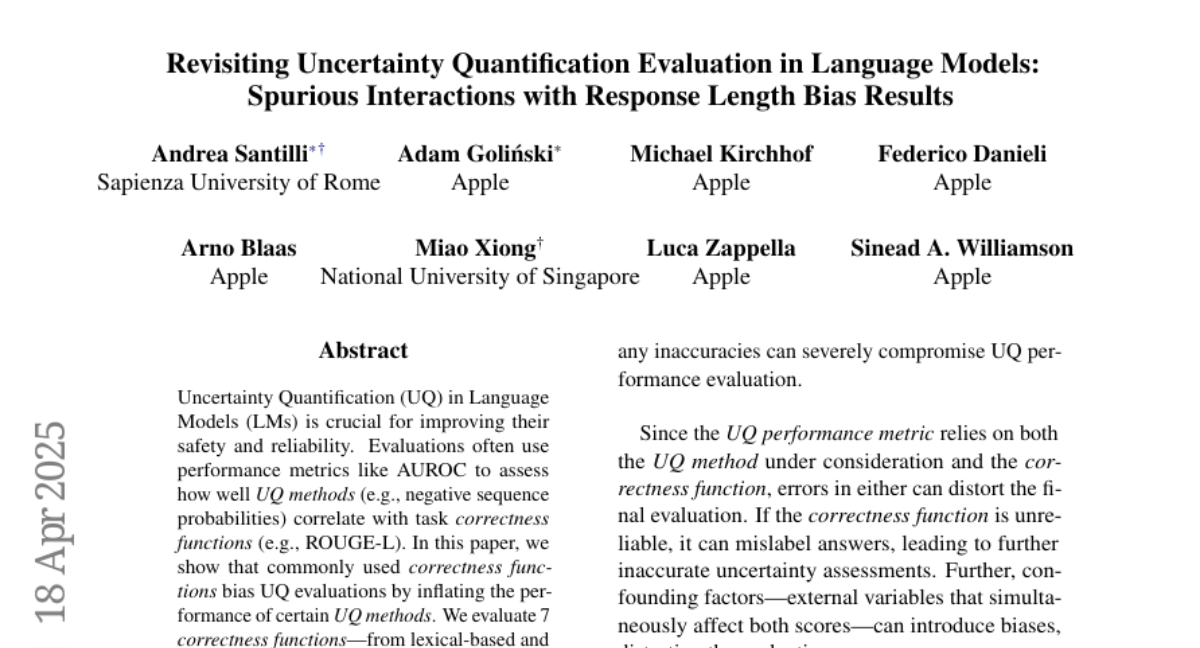
17.
